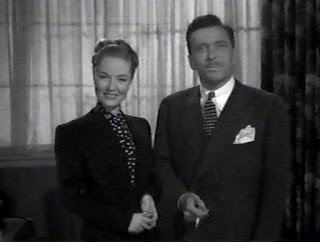 Lady in the Lake (Robert Montgomery, 1947) Call it an experiment that fails—but a noble try. Bob Montgomery took his opportunity to make a low-budget pot-boiler of Raymond Chandler's Philip Marlowe mystery and take it as close to the source as he could...in spirit, anyway. Taking Chandler's first-person narration-style and translating it into cinematic terms. Instead of reading inside Marlowe's head, we're seeing out of his eye-sockets—I didn't know Marlowe was monocular. Nor did I know he was borderline schizophrenic—with cooing voices in the background, passing for a dramatic score (at least it's organic).
Lady in the Lake (Robert Montgomery, 1947) Call it an experiment that fails—but a noble try. Bob Montgomery took his opportunity to make a low-budget pot-boiler of Raymond Chandler's Philip Marlowe mystery and take it as close to the source as he could...in spirit, anyway. Taking Chandler's first-person narration-style and translating it into cinematic terms. Instead of reading inside Marlowe's head, we're seeing out of his eye-sockets—I didn't know Marlowe was monocular. Nor did I know he was borderline schizophrenic—with cooing voices in the background, passing for a dramatic score (at least it's organic).Chandler hated this one. He'd written his own screenplay adaptation (that wasn't used) and thought the POV work...didn't work. It doesn't, really. In fact, it's creepy. We, the audience, are constantly being talked to directly, with Marlowe's replies in voice-over—but because we don't see him, those replies are so "on-the-nose" as to be bluntly obvious. In a way, this direct method robs us of actually seeing Marlowe's thoughts, playing across the face of the actor portraying him. No, Marlowe has to say everything on his mind, making him the lamest of detectives—he's always telling people of his suspicions of them. Nice detective work, there, shamus.
But, it does follow the story...in the same way a stage play might follow it. We're kinda "stuck" inside Marlowe's head, and any investigation—the thing that distinguishes this story in the Marlowe canon is that it takes him out of L.A. But, we never get out of rooms. We lose some characters, and the bigger shocks (the discovery of "the lady in the lake," for instance, which they probably couldn't show as it's pretty gruesome in the book) are talked about happening off-camera. Nope. Everybody's standing around talking to each other...actually they're standing around talking to us.
Like I said, creepy.
It also kills any momentum. Because the camera is the only thing that has any action to it. We see what he sees, following babes—rather obviously—every door-knob that is reached for (how exciting!), and only see our hero in the mirror. It doesn't help the actors, either. Montgomery might have been a great Marlowe—we just don't see it. And poor Audrey Totter—her character doesn't even make any sense. She whip-saws between emotions in a bi-polar performance, that when Marlowe's supposed to trust her, you just don't buy it...or buy him for doing it. The technique works against everything here. The only one who adapts well to it is Lloyd Nolan, but he'd already done an adaptation of Chandler's "The High Window" as the Marlowe stand-in, and already had the "cracking wise" patter down cold.
The thing is, POV can work. It works to a certain extent in Dark Passage, and Jonathan Demme employed it amazingly well—and sparingly—in The Silence of the Lambs, where audience identification is only enhanced by our seeing the direct play of emotions across faces. Montgomery was an actor, and a good one, so it's amazing that he would choose to do this experiment rather than trust his own craft; it's a hard lesson to learn, but an easy one when you think about it—you can tell an audience anything you like, but to use the medium of movies to its best extent—you should show them.
 |
| Robert Montgomery as Phillip Marlowe in the only way we see him (except when addressing the audience)—in a mirror. |





No comments:
Post a Comment